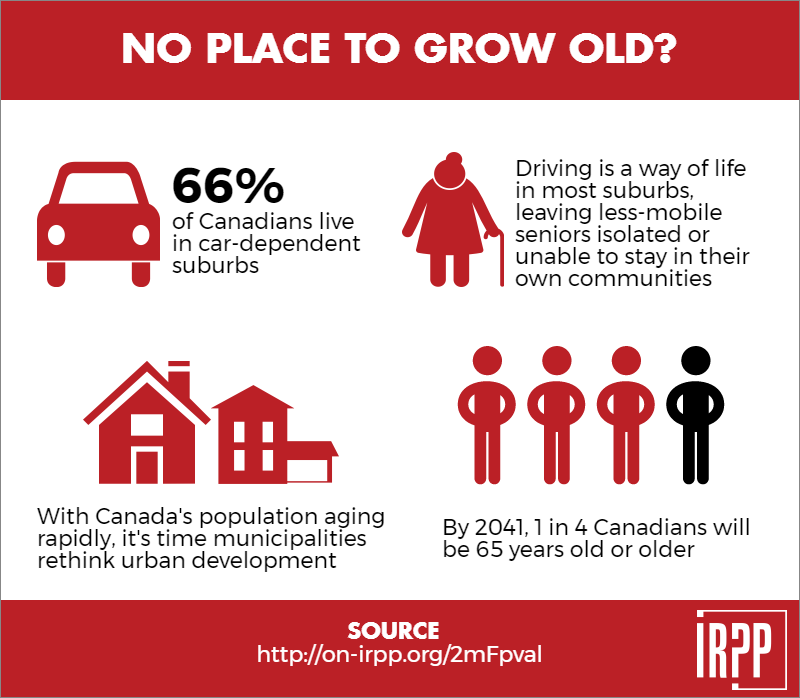Like every other city in Canada, Toronto is ageing. Its older population is expected to grow by 60 per cent in the next 20 years alone. To address this coming of age, the City developed its first Seniors Strategy in 2013 and is now working on updating it. One of the lingering issues is how to maintain the quality of life of older Torontonians as they give up their driver’s licences.
Although many of Toronto’s older neighbourhoods are compact, walkable and potentially ‘age-friendly,’ the same cannot be said for its suburbs developed since the Second World War, where walking or even cycling to shops, medical appointments or community centres is not often an option.
It doesn’t take much imagination to realize that living without a car in the suburbs will be a challenge for a generation used to the freedom and sense of independence offered by driving. The risk of social isolation for older adults in our suburbs starts to look very real as they lose their driver’s licences and mobility. It’s part of the reason urban planner Gordon Harris says “suburbs are no place to grow old!” It was also the title of a recent Institute for Research on Public Policy report.
Older Ontarians tend to outlive their decision to stop driving by a decade, and analyzing similar car-dependent communities surrounding Toronto, our Ministry of Transportation forecasts that within 20 years, only 42 per cent of those aged 75 and over will still have driver’s licences. A recent Statistics Canada report further found that one-quarter of Canadians diagnosed with Alzheimer’s disease or another form of dementia had a driver’s licence, while three-quarters of them reported driving a vehicle in the last month. We clearly need to offer our ageing population reliable alternatives to driving.
Even though municipalities may be improving bus services, better transit isn’t necessarily going to solve mobility problems facing older Ontarians who have given up driving. Indeed, research shows that the likelihood of older adults successfully transitioning from driving to using public transit remains extremely low, particularly for older men.
To encourage older adults to use public transit, it needs to be convenient, accessible, comfortable and affordable as follows:
- Transit needs to be close to home and deliver the traveller reasonably close to the desired destinations, and it needs to be available when it’s needed, such as in off-peak periods.
- Low-floor buses have helped make transit more accessible but older adults need to know that every bus or streetcar is equipped the same way. As the population ages, the use of walkers, wheelchairs and other mobility devices is becoming more common, requiring adaptability from transit vehicles and their operators.
- Transit needs to be seen as a safe, comfortable and a pleasant way to get around. A bad experience being upended by a sudden stop or start can turn older adults away from transit for good.
- Transit also has to be affordable. Even though many transit agencies offer discounts for older users, if a taxi trip is needed to complete the journey, then the discounted fare becomes irrelevant.
It’s unlikely that public transit will be able to meet all of these needs, so the more recent prospect of self-driving cars is increasingly being seen as an intriguing panacea. Just a year ago, so-called ‘autonomous vehicles’ were rated as futuristic marvels, with tech website Business Insider forecasting that by 2020 there will be more than 10 million driverless cars on the road. Now, the Ontario government has launched a pilot project in Waterloo, with the goal of cementing Ontario’s reputation for developing autonomous driving technology.
The advent of this technology could have a huge impact on the lives of older adults who are no longer able to drive. But before we collectively decide this will be the answer to the prayers of suburban older adults, we should take a step back and remember that older Canadians are likely going to have unique needs that the ride-sharing industry will have to consider.
Indeed, ride-sharing works great for 25 year olds, but it also has to be delivered in a variety of different ways to become a useful alternative for 85 year olds, a number of whom still do not own a smart phone or have never downloaded an app, or are looking for more arm-in-arm and door-to-door support during their journeys.
Of course with an expected doubling in the number of older Canadians living with dementia in the next 20 years, many older adults won’t be able to benefit from self-driving cars or ride-sharing services if they can’t understand how to use the technology or exactly where and when they’re going in the first place. For these services and technologies to truly benefit older Canadians, they need to start anticipating and considering their unique needs early and be prepared to adapt their models as quickly as they develop them. Indeed, the providers who figure out how to preserve and give older adults their mobility and a sense of independence back will help them stay engaged and active members of their communities which will benefit all of us too.
Toronto and its suburbs are as car-dependent as any city, but now is the time for us to consider how we can help everyone remain mobile and engaged right until the end.
Date modified: 2017-04-11


